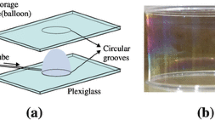Abstract
The developments of a membrane-less SF6 gas cylinder under reshock conditions are experimentally investigated in this work. Illuminated by a continuous laser sheet, the interface morphology is characterized by glycol droplets and captured by a high-speed camera. It is found that different phenomena are observed for different end wall distances. The effect of the reshock is more pronounced on the interface morphology if interaction occurs at later times for the reshock times studied, i.e. for farther end wall positions. The variations of interface dimensions over time are given to demonstrate the influence of reshock on the interface development. Moreover, the velocities of the upper and lower interfaces are measured and compared with the theoretical ones calculated from the one-dimensional model and a good agreement is obtained. The change of the interface height shows that reshock promotes the Richtmyer–Meshkov instability process.
Graphical Abstract







Similar content being viewed by others
References
Andronov V, Bakhrakh S, Meshkov E, Nikiforov V, Mokhov V, Pevnitskii A, Tolshmyakov A (1976) Turbulent mixing at contact surface accelerated by shock waves. Sov Phys JETP 44:424–427
Balakumar B, Orlicz G, Tomkins C, Prestridge K (2008) Simultaneous particle-image velocimetry-planar laser-induced fluorescence measurements of Richtmyer–Meshkov instability growth in a gas curtain with and without reshock. Phys Fluids 20:124103
Balakumar B, Orlicz G, Ristorcelli J, Balasubramanian S, Prestridge K, Tomkins C (2012) Turbulent mixing in a Richtmyer–Meshkov fluid layer after reshock: velocity and density statistics. J Fluid Mech 696:67–93
Balasubramanian S, Orlicz G, Prestridge K, Balakumar B (2012) Experimental study of initial condition dependence on Richtmyer–Meshkov instability in the presence of reshock. Phys Fluids 24:034103
Brouillette M (2002) The Richtmyer–Meshkov instability. Annu Rev Fluid Mech 34:445–468
Brouillette M, Sturtevant B (1993) Richtmyer–Meshkov instability: small-scale perturbations on a plane interface. Phys Fluids A 5:916–930
Fan M, Zhai Z, Si T, Luo X, Zou L, Tan D (2012) Numerical study on the evolution of the shock-accelerated SF6 interface: influence of the interface shape. Sci China Phys Mech Astron 55:284–296
Haehn N, Weber C, Oakley J, Anderson M, Ranjan D, Bonazza R (2012) Experimental study of the shock-bubble interaction with reshock. Shock Waves 22:47–56
Hill D, Pantano C, Pullin D (2006) Large-Eddy simulation and multiscale modeling of a Richtmyer–Meshkov instability with reshock. J Fluid Mech 557:29–61
Jacobs J (1993) The dynamics of shock accelerated light and heavy gas cylinders. Phys Fluids A 5:2239–2247
Kumar S, Orlicz G, Goodenough C, Prestridge K (2005) Stretching of material lines in shock-accelerated gaseous flow. Phys Fluids 17:082107
Latini M, Schilling O, Don W (2007) High-resolution simulations and modeling of reshocked single-mode Richtmyer–Meshkov instability: Comparison to experimental data and to amplitude growth model predictions. Phys Fluids 19:024104
Leinov E, Malamud G, Elbaz Y, Levin L, Bendor G, Shvarts D, Sadot O (2009) Experimental and numerical investigation of the Richtmyer–Meshkov instability under reshock conditions. J Fluid Mech 626:449–475
Meshkov E (1969) Instability of the interface of two gases accelerated by a shock wave. Fluid Dyn 4:151–157
Niederhaus J, Greenough J, Oakley J, Ranjan D, Anderson M, Bonazza R (2008) A computational parameter study for the three-dimensional shock-bubble interaction. J Fluid Mech 594:85–124
Picone J, Boris J (1988) Vorticity generation by shock propagation through bubbles in a gas. J Fluid Mech 189:23–51
Prestridge K, Rightley P, Vorobieff P, Benjamin R, Kurnit N (2000) Simultaneous density-field visualization and PIV of a shock-accelerated gas curtain. Exp Fluids 29:339–346
Ranjan D, Oakley J, Bonazza R (2011) Shock-bubble interactions. Annu Rev Fluid Mech 43:117–140
Richtmyer R (1960) Taylor instability in shock acceleration of compressible fluids. Commun Pure Appl Math 13:297–319
Si T, Zhai Z, Luo X, Yang J (2012) Experimental investigation of reshocked spherical gas interfaces. Phys Fluids 24:054101
Tomkins C, Kumar S, Orlicz G, Prestridge K (2008) An experimental investigation of mixing mechanisms in shock-accelerated flow. J Fluid Mech 611:131–150
Vetter M, Sturtevant B (1995) Experiments on the Richtmyer–Meshkov instability of an air/SF6 interface. Shock Waves 4:247–252
Zabusky N (1999) Vortex paradigm for accelerated inhomogeneous flows: visiometrics for the Rayleigh-Taylor and Richtmyer–Meshkov environments. Annu Rev Fluid Mech 31:495–536
Zhai Z, Si T, Luo X, Yang J (2011) On the evolution of spherical gas interface accelerated by a planar shock wave. Phys Fluids 23:084104
Zoldi C (2002) Numerical and experimental study of a shock-accelerated heavy gas cylinder. PhD thesis, State University of New York at Stony Brook, America
Acknowledgments
This research is supported by the National Natural Science Foundation of China (11272308, 11302219), the Fundamental Research Funds for Central Universities (WK2090050020) and the China Postdoctoral Science Foundation (BH2090050031).
Author information
Authors and Affiliations
Corresponding author
Rights and permissions
About this article
Cite this article
Zhai, Z., Zhang, F., Si, T. et al. Evolution of heavy gas cylinder under reshock conditions. J Vis 17, 123–129 (2014). https://doi.org/10.1007/s12650-014-0198-1
Received:
Revised:
Accepted:
Published:
Issue Date:
DOI: https://doi.org/10.1007/s12650-014-0198-1




